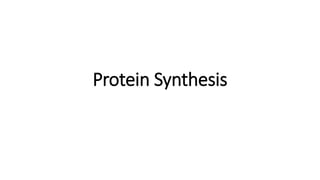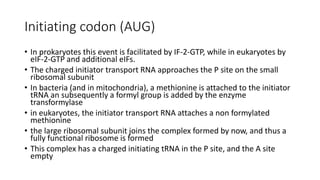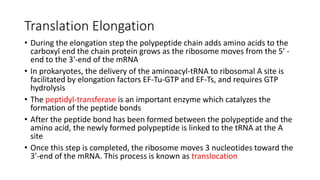Protein Synthesis.pptx
- 2. Content âĒ Definition âĒ Location in the cell âĒ Requirements âĒ Steps involved âĒ Initiation âĒ Elongation âĒ Termination âĒ Antibiotics inhibits the protein synthesis
- 3. âĒ The process of protein synthesis translates the codons (nucleotide triplets) of the messenger RNA (mRNA) into the 20-symbol code of amino acids that build the polypeptide chain of the proteins âĒ mRNA translation begins from its 5âē-end towards its 3âē-end âĒ The polypeptide chain is synthesized from its amino-terminal (N-end) to its carboxyl-terminal (C-end). âĒ no significant differences in the protein synthesis steps in prokaryotes and eukaryotes, however there is one major distinction between the structure of the mRNAs â prokaryotes often have several coding regions (polycistronic mRNA), while the eukaryotic mRNA has only one coding region (monocistronic mRNA
- 4. Protein Synthesis Steps involved âĒ Initiation âĒ Elongation âĒ Termination
- 7. Protein Synthesis Initiation âĒ The components involved in the first step of protein synthesis are: âĒ The mRNA to be translated âĒ the two ribosomal subunits (small and large subunits) âĒ the aminoacyl-tRNA which is specified by the first codon in the mRNA âĒ guanosine triphosphate (GTP), which provides energy for the process â eukaryotes require also adenosine triphosphate! âĒ initiation factors which enables the assembly of this initiation complex - prokaryotes have 3 initiation factors are known (IF-1, IF-2, and IF-3), while eukaryotes, there have over ten factors designated with eIF prefix.
- 9. Two mechanisms are involved in the recognition sequence âĒ Shine-Dalgarno (SD) sequence - In Escherichia coli is observed sequence with high percentage of purine nucleotide bases, known as the Shine-Dalgarno sequence. This region is located close to 5â end of the mRNA molecule, 6-10 bases upstream of the initiating codon. The 16S rRNA component of the small ribosomal subunit possess a complementary to the SD sequence near its 3'-end.
- 10. Initiating codon (AUG) âĒ In prokaryotes this event is facilitated by IF-2-GTP, while in eukaryotes by eIF-2-GTP and additional eIFs. âĒ The charged initiator transport RNA approaches the P site on the small ribosomal subunit âĒ In bacteria (and in mitochondria), a methionine is attached to the initiator tRNA an subsequently a formyl group is added by the enzyme transformylase âĒ in eukaryotes, the initiator transport RNA attaches a non formylated methionine âĒ the large ribosomal subunit joins the complex formed by now, and thus a fully functional ribosome is formed âĒ This complex has a charged initiating tRNA in the P site, and the A site empty
- 11. Translation Elongation âĒ During the elongation step the polypeptide chain adds amino acids to the carboxyl end the chain protein grows as the ribosome moves from the 5' - end to the 3'-end of the mRNA âĒ In prokaryotes, the delivery of the aminoacyl-tRNA to ribosomal A site is facilitated by elongation factors EF-Tu-GTP and EF-Ts, and requires GTP hydrolysis âĒ The peptidyl-transferase is an important enzyme which catalyzes the formation of the peptide bonds âĒ After the peptide bond has been formed between the polypeptide and the amino acid, the newly formed polypeptide is linked to the tRNA at the A site âĒ Once this step is completed, the ribosome moves 3 nucleotides toward the 3'-end of the mRNA. This process is known as translocation
- 13. Termination of Translation âĒ Termination happens when the A site of the ribosome reaches one of the three termination codons (UAA, UAG or UGA) âĒ In prokaryotes, these codons are recognized by different release factors (abbreviated with RF) âĒ When these release factors bind the complex, this cause in hydrolysis of the bond linking the peptide to the tRNA at the P site and releases the nascent protein from the ribosome















